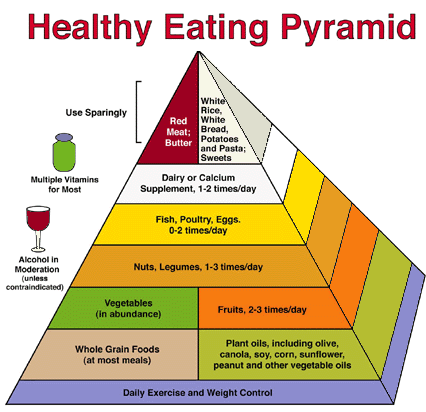 |
|
 |
Problems with the USDA Pyramid
Some researchers, like Meir Stampfer, MD, DrPH, of the Harvard University School of Public Health (who served on the committee for the 2000 Guidelines update), and Walter Willett, MD, DrPH, chair of the Department of Nutrition at Harvard, think that the USDA's Food Guide Pyramid is outdated and additional changes should have been recommended. In fact, Willett's book Eat, Drink, and Be Healthy offers another pyramid model that makes more distinctions. Among the differences from the USDA model, the Harvard Healthy Eating Pyramid" puts nuts and legumes in their own category instead of lumping them together with fish, poultry, and eggs. It de-emphasizes dairy products, placing them in a category with calcium supplements. It further recommends a daily multivitamin supplement and allows for moderate alcohol consumption, as appropriate. The Harvard Pyramid Summary of Differences1. The Harvard Pyramid rests on a base of daily exercise and weight control, and it’s much more than just carbohydrates compared to fats. 2. While the top of the USDA's Pyramid, the “Use Sparingly” category, includes all fats and oils, this assumes that all fats are bad. There are big differences among saturated fats, trans-fats, and unsaturated fats. - Saturated animal fats are not as good as vegetable sources of fats, but far worse are the food industry’s trans-fats, created by bubbling hydrogen through vegetable oil. The process of hydrogenation, produces a solid fat that takes a long time to spoil. Producers want it for cookies, crackers, packaged snacks, and many other items that travel from factories to distant supermarket shelves. Fast-food restaurants use hydrogenated vegetable fat for frying. Trans-fat, is much more harmful than natural saturated fat, but many studies failed to distinguish between the two.
- The unsaturated fats in most vegetable oils, nuts, seeds, whole grains, and fish have important health benefits, so they are placed close to the base of the Harvard Pyaramid. Saturated fats, like those in red meat and butter, are at the very top, in the “Use Sparingly” category.
3. The USDA Pyramid is that it encourages eating up to 11 servings a day from the bread, cereal, rice, and pasta group at its base without distinguishing between whole grains and refined carbohydrates, which act similar to sugar. - The carbohydrates in fruits and vegetables exist in combination with fiber, which slows their digestion and avoids the blood-sugar ups and downs of refined carbohydrates.
4. The USDA Pyramid also lumps the proteins—meat, eggs, nuts, and legumes together. While they are all good sources of protein, they differ biologically. Fatty red meats and processed meats increase the risk of heart disease and cancer, while the fat in fish, nuts and legumes actually protects against heart disease.
|
 |
 |
|
 |
|
|
|
|
|
|
|
|
|
|
|
|
|
|
 |
|
 |
|
 |
|
 |
|
 |
|
 |
|
 |
 |
 |
 |
| |
 |
Pregnancy
Over the past decade, revolutionary discoveries in neuroscience and developmental psychology have shattered long-held misconceptions about fetal devel more... |
|
 |
Helping Professionals
This area consists of text from Wellness for Helping Professionals, by John W. Travis, MD, and Meryn Callander. more... |
|
 |
Child/Family Wellness
Honoring the heart, soul, and spirit of our children, our families, and our future. After more than three decades of pioneering work in adult wellness, and giving birth to a daughter, Siena, in 1993, Meryn and John realized that the more... |
|
 |
|
 |


